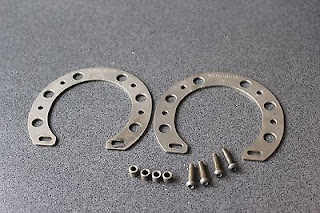What are some telltale signs of an early '90s mountain bike?
One might be bar ends, especially those from Onza and Club Roost. Another could be early Rock Shox or Manitou suspension (or "telescoping," according to the Brits) front fork--or a sprung rear triangle.
Another popular form of suspension was built into handlebar stems, such as the ones from Girvin or Softride. I never tried one myself, but I suspect they didn't do nearly as much to dampen shock--and make a ride more stable--as a suspended fork or rear triangle. I suspect, though, another reason why they fell out of favor is that spension forks led to two nearly-simultaneous changes: 28.6 mm (1 1/8") steerer tubes replaced 25.4 (1") as the new standard, and threadless headsets became an industry standard. Girvin and other suspension stems were of the "quill" type and manufacturers couldn't, or didn't want to, make threadless suspension stems.
Well, in the cycling world, very few ideas actually die. SunTour made cassette hubs and indexed shifting in 1969. I've never seen them, but from what I've read and heard, they worked well. The market wasn't ready for them, however, until Shimano re-introduced them a decade and a half later. Likewise, suspension stems didn't end up as road- (or trail-) kill. A recent trend has brought them back from the dustbin of cycling history.
Gravel biking is credited for showing that wider tires aren't only for mountain bikes or beach cruisers. It also has renewed interest in minimalist, lightweight forms of suspension. Most suspension forks are simply too heavy, and too dampening, for gravel bikers' tastes. Those forks also have straight or nearly-straight blades, which negate the benefits of the low-trail bikes' geometries. And I don't know how feasible rear-triangle suspension is for a gravel bike.
During the past couple of years, some new suspension stems have appeared on the market. Unlike Girvin and Softride, the new Shock Stop and Kinekt models are threadless stems. The former uses swappable elastomer inserts, rather like a few of the 90s suspension forks and USE fork. Not coincidentally, Shock Stop offers an elastomer-equipped seatpost to complement its stem. Kinekt, on the other hand, uses a parallelogram system reminiscent of the Soft Ride.
In my limited experience with suspension systems, one problem I found with elastomers is that dirt, moisture or cold stiffened them. A mechanical system like Kinekt might be heavier, but more reliable, and avoids the problem of manufacturers who discontinue replacement elastomers (or go out of business). I am not making any recommendations, as I have never used any new or old suspension stem. I do find it interesting, however, that a new trend in riding has given an old idea a new lease on life.

































